A drought this spring has our weeds and grasses going to seed early. Normally we would not be watering the gardens this time of year, but it’s needed already. Our members of the Plantago genus are looking more summer-like. This is the super first-aid weed. It has impressive wound healing properties, and is even useful for counteracting snakebite from the hyaluronidase producing snakes such as copperheads and rattlers. Combined with echinacea root, it has been successfully used internally and as a poultice, in large quantities, for these kinds of bites. This same treatment is used for the brown recluse and hobo spider bites, which also feature the tissue dissolving hyaluronidase. Suburbanites should defy their HOA, and make sure to keep some of these weeds around. Plantago psyllium (a.k.a Plantago afra) is a commercial weed, the seeds of which are used as an aperient, bulk forming laxative. Plantago ovata, blond psyllium is the Asian weed with the same use.
Plantain is a great salad weed when very young, and older plants can be consumed by those who don’t mind the much stronger flavor, and having their teeth flossed by the fibrous ribs of the leaves while they eat.
Our plantains are members of the family Plantaginaceae, which has lately been expanded to include such things as the snapdragons, speedwells, foxgloves, waterstarworts and turtleheads. Before those grad students got a hold of it, the family was a lot smaller, consisting mostly of the plantago genus of a couple hundred species or so. The two most famous and disorderly species are Plantago major, a very broad leafed plant, and Plantago lanceolata, the flowering heads of which you have most likely seen. This latter plant is considered an invasive weed of the whole of Japan, but is generally the preferred plant in Europe for medicinal use. They are an emblem of disturbance, cropping up in dry gravel roadways, footworn trails, and construction sites everywhere. Home zones are from 3a to 9b, and they prefer a soil pH between 6.5 and 9. This tolerance for alkalinity is why these weeds show up abundantly in our limestone gravel driveway, and where we’ve been spreading ashes from the fireplace. Leaves of this genus exhibit parallel rib-like veins, as are seen in monocots, but there are fine netted veins between these ribs, so these weeds are dicots. The splitters in grad schools are always moving the furniture around in plant classification, but learning basic differences between monocots and dicots will help with visual plant identification, and noticing plant relationships.
The broad leafed plantain which occupies our region, as well as about 2/3 of the U.S., is largely Plantago rugelii, Rugel’s plantain or blackseeded plantain, which can be distinguished largely by the purple tinged petioles of the leaves, down close to the base. Plantago major leaf petioles lack that purple tinge. Plantago intermedia is a similar plant which occupies the northern right and the left coastal states of the U.S. You’ll find some references lumping these species as varieties of Plantago major. They’re similarly useful as food and medicine, but they do differ in the proportion of medicinal constituents which have been found. An excellent photographic comparison of Plantago rugelii and Plantago major is done by the folks at Minnesota Wildflowers. The plant below is Rugel’s plantain. We rarely see the Plantago major at weedom.

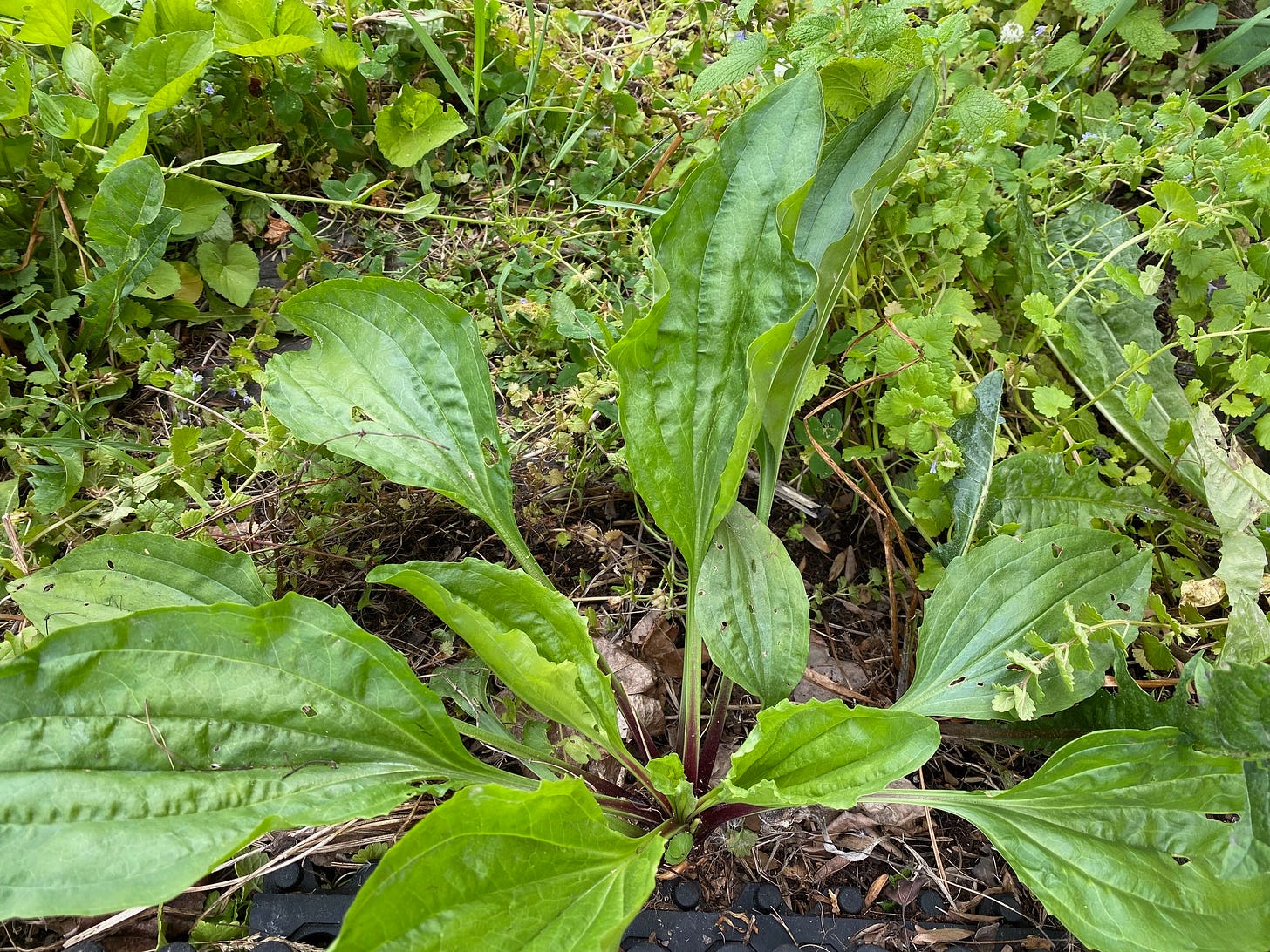
Later in the life of Plantago major and rugelii, flowering stems are successively sent up which look a bit like rat-tails. Tiny whitish flowers have 4 triangular petals and 4 pointed green sepals. Use a magnifying glass. The distinctive flowering heads of Plantago lanceolata are sent up on long thin stems and characterized by a prominent ring of anthers which project horizontally. All of the plantains are highly adaptable. If you mow them down, they’ll just sent up shorter stems. Reproduction will happen, one way or another. (Our plantains dandelions and violets seem to eventually figure out the height of the lawnmower blade. )
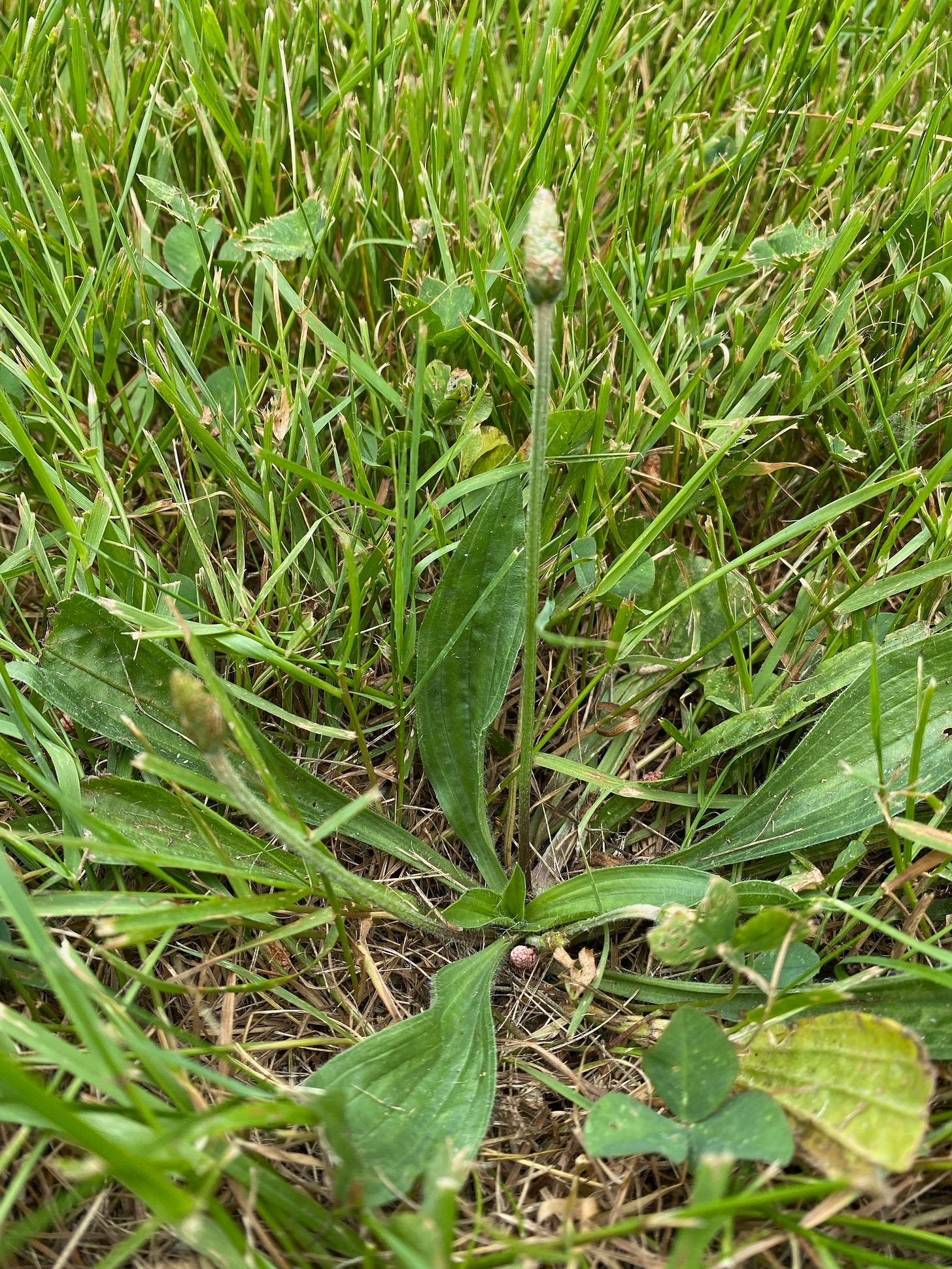
For many of the edible and medicinal uses of plantain, people will be most interested in the young plants, which are more tender, and better flavored, and contain a different array of medicinal compounds, and notably higher concentration of iridoid glycosides. Plantago rugelii seems to mature later and retain palatability longer than Plantago major, and is often preferred by foragers for eating. At weedom, we lean towards the narrow leaf, plantago lanceolata for the worst tasting medicines, such as anti-infectives, and to plantago rugelii for the soothing of coughs and mucosal injuries of the mouth, throat, GI tract. Mix them to cover all the basis. Either can be used for relief of stings and insect bites. As edible weeds, Plantago major and Plantago lanceolata have favorably defined nutritional profiles, with a good amount of vitamins E, C, and K, beta carotene, and minerals, a favorable ratio of oxalic acid to calcium, a good source of potassium, magnesium and iron, and relatively low available carbohydrate content. Oxalic acid (which reduces availability of dietary calcium, and can contribute to formation of kidney stones) levels trend significantly lower in our plantain species than many cultivated vegetables, as well as commonly foraged species. Nitrate content is also relatively low, and not an issue with respect to normal human consumption. Overall Plantain is a top spinach substitute among the foraged edible greens. Let it grow!!
Plantago lanceolata contains varying amounts of iridoids and iridoid glycosides, from 9% in young leaves, with the amount of catapol dominating over that of aucubin, and much lower percentages in mature leaves, but with aucubin dominating. Drying at room temperature will result in increased yield of 1-3% aucubin and 1 % catapol. Other iridoid glycosides present are asperuloside, desacetylasperuloside-acid methylester and globularin. Plantain should be dried immediately in a darkened location to avoid loss of material via hydrolysis and fermentative processes. Brown color reveals that aucubin has polymerized and is no longer available. Many herbalists recommend use of the fresh material for tincturing in stronger ethanol solutions, up to 95%. It’s more difficult to drive sufficient moisture out of the plantain by room temp drying to allow for long term storage. Likely for this reason, dried plantain is considered to have a shorter shelf life than such herbs as the mints, though it is the preferred form for making teas. P. lanceolata contains 2 - 6.5% mucilage, made up of such components as glucomannan, arabinogalactan, and rhamnogalacturonan with an arabinogalactan side-chain as well as rhamnoarabinogalactan and linear (1-6)-α-D-glucan. Some of the flavonoids are apigenin, luteolin and their glucosides, glucuronide and glycoside deriviatives. Tannins, up to 6.5%, an antimicrobial and hemolytic saponin and aesculetin, loliolide, various phenolic carboxylic acids such as chlorogenic acid, hydroxybenzoic acid, protocatechuic acid, and gentisinic acid are present. 1% silicilic acid, and significant mineral salts of zinc and potassium are among the inorganic constituents. Based on limited clinical study, and a vast history of traditional use, numerous medicinal products containing Plantago lancinata are on the market, with the bulk of them addressing cough and inflammation of the oral and pharyngeal mucosa. The usual adult daily dose is 3-6 gram equivalents of the dried plant material, whether suspended as a tea or a tincture. Plantago major significantly echos the chemical profile of Plantago lanceolata, though proportions of the constituents vary. For wound care, and many other applications these plants could be mixed or used interchangeably, and most herbalists will do this. Plantago rugelii is known to contain the same major classes of constituents as P. major and P. Lanceolata but has not been exhaustively characterized. Studied in mice it seemed quite effective for protection against induced stomach ulcers.
A number of compounds found in narrow and broadleaf plantain have been found to inhibit various hyaluronidases. (These enzymes dissolve your connective tissue, and allow for biting pests to suck out liquified bits of you.) Why do you want to know that? So you can consider these weeds for relief of stings, insect bites, spider bites, and some snakebites. Combine them with plenty of echinacea root (also inhibits hyaluronidases, and is anti-infective) if you have it, particularly for such things as pit viper bites. These are the hyaluronidase producing snakes, such as rattlers and copperheads, etc. Brown recluse and hobo spiders are similar. While you would likely see a physician to see if antibiotics and surgery are needed, allopathic medicine seems not to have much power against these kinds of spider bites, to prevent those hyaluronidase enzymes from degrading your connective tissue. There is nothing to be lost by poulticing the bite, and consuming a very safe herb such as plantain to help yourself. You can eat it directly, or drink the tea several times daily. This action against hyaluronidase provides part of the explanation for the “drawing” power attributed to Plantago species, where ever you see, “plantain draws out the toxins” in the literature of herbalism. Relaxation of smooth muscle and anti-inflammatory effects might also explain how foreign objects such as stingers and splinters seem to be “drawn out” and more easily extracted from wounds. Herbalists will tell you to chew up the plantain leaf and rub it on a sting, or make a poultice. At weedom, we have a bit of germophobia, and question whether adding gut bacteria to a wound is great, so we grind plantain up by any other means available, and put the mashed up product on stings and bug bites. Numerous anti-inflammatory, anti-infective and anti-hyaluronidase compounds account for the sting and bite relief of plantain. We have yet to personally encounter a copperhead, and rattlers have not been reported in our region, so we refer you westward to a veterinarian and herbalist who is known for treating such things in animals as well as humans.
It’s very likely that your local plantain weeds will have some apigenin, luteolin, and/or calceorioside B, etc. to help you with those stings and bites.
Plantago species represent an entire pharmacy with respect to the practice of herbalism. Since we presented only some prominent warm season uses we will return to plantain to explain its many internal uses during cooler months when fewer weeds are visible. It should be one of your top 10 weeds if you live within Zones 3-9. Use it fresh during the growing season, and dry it with as little heat as possible for the winter season. Repeat at least yearly, since this herb seems to lose parts of its potency faster than others. If you have a freeze dryer, your dried stuff will be better than ours, though we do a pretty good job. What are you doing with plantain? Are you using a different local species? Plant some comments here! Tell us in Notes!
Where we dig
1. Cyril O, Eboka C, Igbe I. Anti-Ulcer activity of methanol extract of Plantago rugelii Decne. (Plantaginaceae). Tropical Journal of Natural Product Reseach. 2017;1:84-88. doi:10.26538/tjnpr/v1i2.7
2. Santos WBDR, Guimarães JO, Pina LTS, Serafini MR, Guimarães AG. Antinociceptive effect of plant-based natural products in chemotherapy-induced peripheral neuropathies: A systematic review. Front Pharmacol. 2022;13:1001276. doi:10.3389/fphar.2022.1001276
3. Assessment report on Plantago afra L. et Plantago indica L., semen. EMA/HMPC/599745/2012
4. Assessment report on Plantago lanceolata L., folium. EMA/HMPC/437859/2010
5. Buckhorn plantain, ribgrass, ribwort, common plantain / Invasive Species of Japan. Accessed June 5, 2023. https://www.nies.go.jp/biodiversity/invasive/DB/detail/80380e.html
6. Adom MB, Taher M, Mutalabisin MF, et al. Chemical constituents and medical benefits of Plantago major. Biomed Pharmacother. 2017;96:348-360. doi:10.1016/j.biopha.2017.09.152
7. Rønsted N, Gøbel E, Franzyk H, Jensen SR, Olsen CE. Chemotaxonomy of Plantago. Iridoid glucosides and caffeoyl phenylethanoid glycosides. Phytochemistry. 2000;55(4):337-348. doi:10.1016/s0031-9422(00)00306-x
8. Budzianowska A, Totoń E, Romaniuk-Drapała A, Kikowska M, Budzianowski J. Cytotoxic Effect of Phenylethanoid Glycosides Isolated from Plantago lanceolata L. Life (Basel). 2023;13(2):556. doi:10.3390/life13020556
9. Jurisić R, Debeljak Z, Vladimir-Knezević S, Vuković J. Determination of aucubin and catalpol in Plantago species by micellar electrokinetic chromatography. Z Naturforsch C J Biosci. 2004;59(1-2):27-31. doi:10.1515/znc-2004-1-206
10. Liu Y, Staerk D, Nielsen MN, Nyberg N, Jäger AK. High-resolution hyaluronidase inhibition profiling combined with HPLC-HRMS-SPE-NMR for identification of anti-necrosis constituents in Chinese plants used to treat snakebite. Phytochemistry. 2015;119:62-69. doi:10.1016/j.phytochem.2015.09.005
11. Girish K, Kemparaju K, Nagaraju S, Vishwanath BS. Hyaluronidase Inhibitors: A Biological and Therapeutic Perspective. Current medicinal chemistry. 2009;16:2261-2288. doi:10.2174/092986709788453078
12. Taskova R, Evstatieva L, Handjieva N, Popov S. Iridoid patterns of genus Plantago L. and their systematic significance. Z Naturforsch C J Biosci. 2002;57(1-2):42-50. doi:10.1515/znc-2002-1-208
13. Monocots versus Dicots | BioNinja. Accessed June 5, 2023. https://ib.bioninja.com.au/higher-level/topic-9-plant-biology/untitled-3/monocots-versus-dicots.html
14. Cyril O, Yelwa A, Bisiriyu M. Pharmacognostic study of the leaf of Plantago rugelii Decne (Plantaginaceae). International Journal of Chemical Sciences. 2017;1:33-36.
15. Plantaginaceae: Plantain Family. Identify plants and flowers. Accessed June 5, 2023. https://www.wildflowers-and-weeds.com/Plant_Families/Plantaginaceae.htm
16. Plantago intermedia (many-seeded plantain): Go Botany. Accessed June 5, 2023. https://gobotany.nativeplanttrust.org/species/plantago/intermedia/
17. Meyer SLF, Zasada IA, Roberts DP, et al. Plantago lanceolata and Plantago rugelii Extracts are Toxic to Meloidogyne incognita but not to Certain Microbes. J Nematol. 2006;38(3):333-338.
18. Plantago major (Broad-leaved plantain, Cart Track Plant, Cuckoo’s bread, Doorweed, Dooryard plantain, Englishman’s-foot, Great plantain, Plantain, Ripple grass, Roundelay plantain, Slan-lus, Snake-plant, Snakeweed, Waybread, Waybroad, Whiteman’s-foot) | North Carolina Extension Gardener Plant Toolbox. Accessed June 5, 2023. https://plants.ces.ncsu.edu/plants/plantago-major/
19. Najafian Y, Hamedi SS, Farshchi MK, Feyzabadi Z. Plantago major in Traditional Persian Medicine and modern phytotherapy: a narrative review. Electron Physician. 2018;10(2):6390-6399. doi:10.19082/6390
20. Fierascu R, Fierascu I, Ortan A, Alina P. Plantago media L.—Explored and Potential Applications of an Underutilized Plant. Plants. 2021;10:265. doi:10.3390/plants10020265
21. Plantago rugelii - Species Page - IPA: Indiana Plant Atlas. Accessed June 5, 2023. https://indiana.plantatlas.usf.edu/plant.aspx?id=2769
22. Plantago rugelii (Rugel’s plantain): Go Botany. Accessed June 5, 2023. https://gobotany.nativeplanttrust.org/species/Plantago/rugelii/
23. Plantago rugelii (Rugel’s Plantain): Minnesota Wildflowers. Accessed June 5, 2023. https://www.minnesotawildflowers.info/flower/rugels-plantain
24. Plantago Species, Broadleaf Plantain, Common Plantain, Greater Plantain, Rat’s Tails Plantago major. Accessed June 5, 2023. https://davesgarden.com/guides/pf/go/2044/
25. Plantain - Farm Homestead. Published April 14, 2017. Accessed June 5, 2023. https://farmhomestead.com/herbs/plantain/,
26. Andoh T, Kato M, Kitamura R, et al. Prophylactic administration of an extract from Plantaginis Semen and its major component aucubin inhibits mechanical allodynia caused by paclitaxel in mice. J Tradit Complement Med. 2016;6(3):305-308. doi:10.1016/j.jtcme.2015.12.001
27. Zhang S, Hu J, Sun Y, et al. Review of structure and bioactivity of the Plantago (Plantaginaceae) polysaccharides. Food Chem X. 2021;12:100158. doi:10.1016/j.fochx.2021.100158
28. Rugel’s Plantain: Pictures, Flowers, Leaves & Identification | Plantago rugelii. Accessed June 5, 2023. https://www.ediblewildfood.com/rugels-plantain.aspx
29. Genc Y, Dereli FTG, Saracoglu I, Akkol EK. The inhibitory effects of isolated constituents from Plantago major subsp. major L. on collagenase, elastase and hyaluronidase enzymes: Potential wound healer. Saudi Pharm J. 2020;28(1):101-106. doi:10.1016/j.jsps.2019.11.011
30. Albahri G, Badran A, Hijazi A, et al. The Therapeutic Wound Healing Bioactivities of Various Medicinal Plants. Life (Basel). 2023;13(2):317. doi:10.3390/life13020317
31. Samuelsen AB. The traditional uses, chemical constituents and biological activities of Plantago major L. A review. J Ethnopharmacol. 2000;71(1-2):1-21. doi:10.1016/s0378-8741(00)00212-9


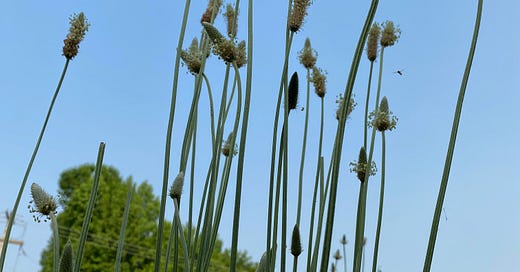



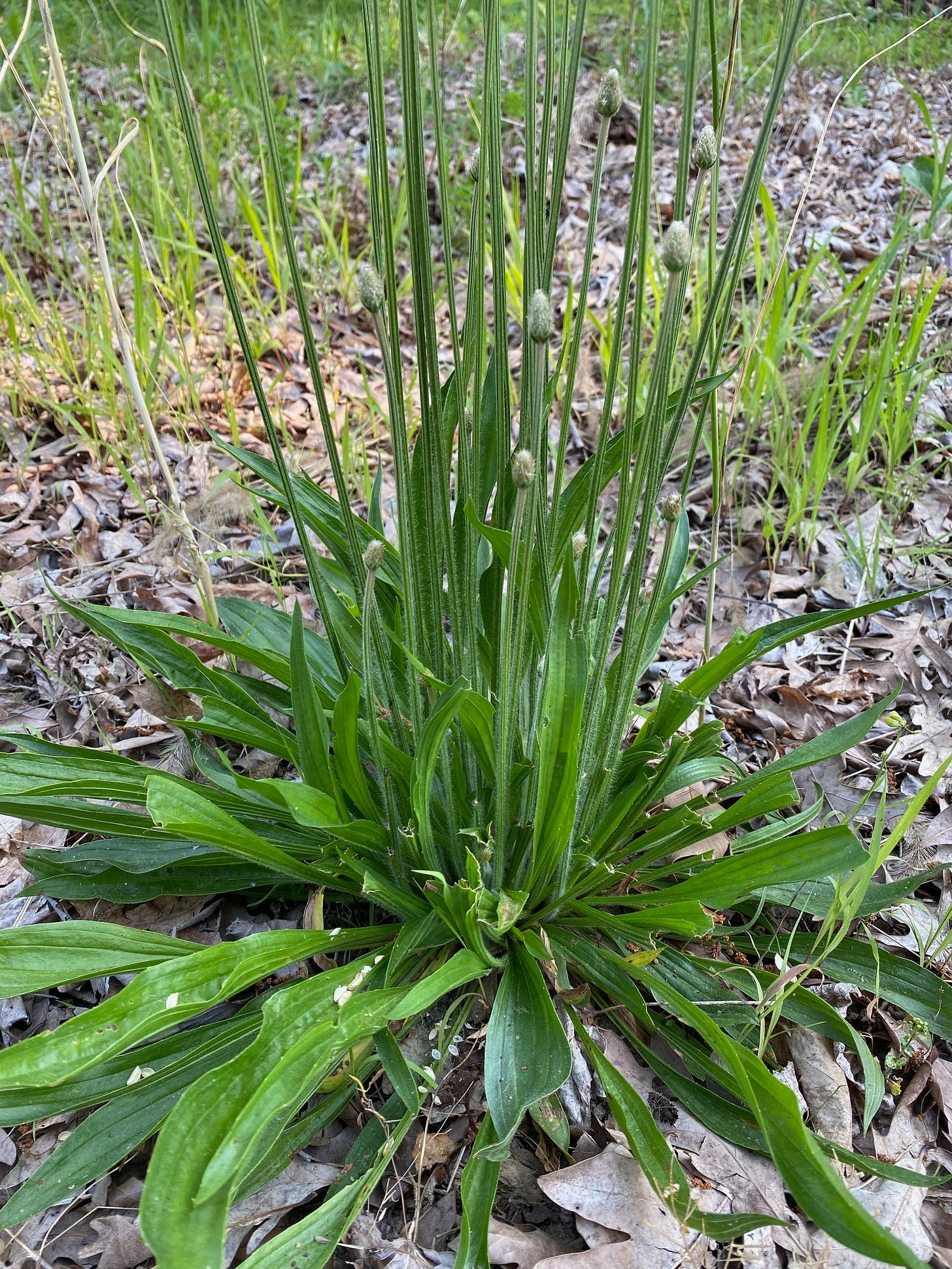
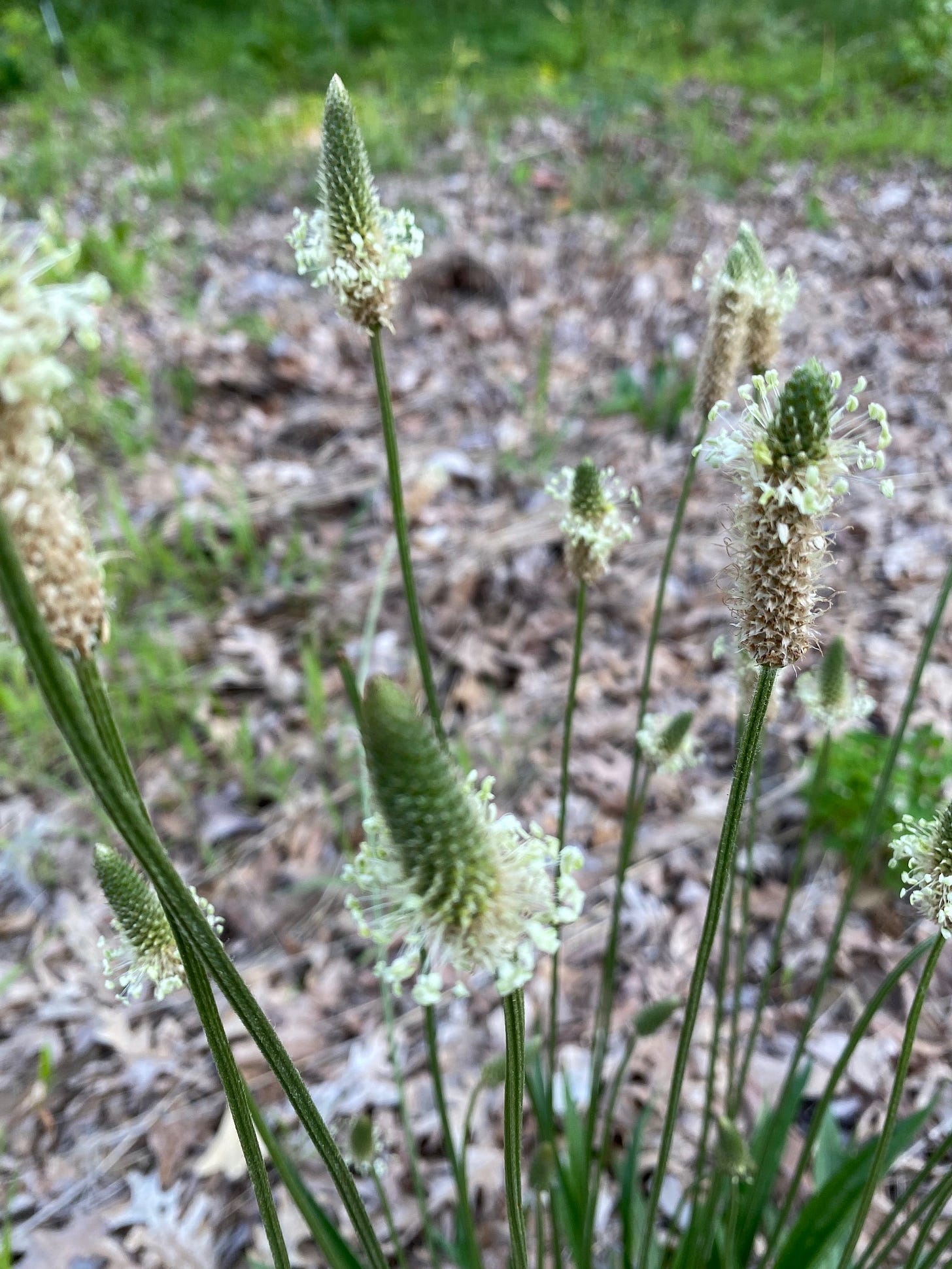
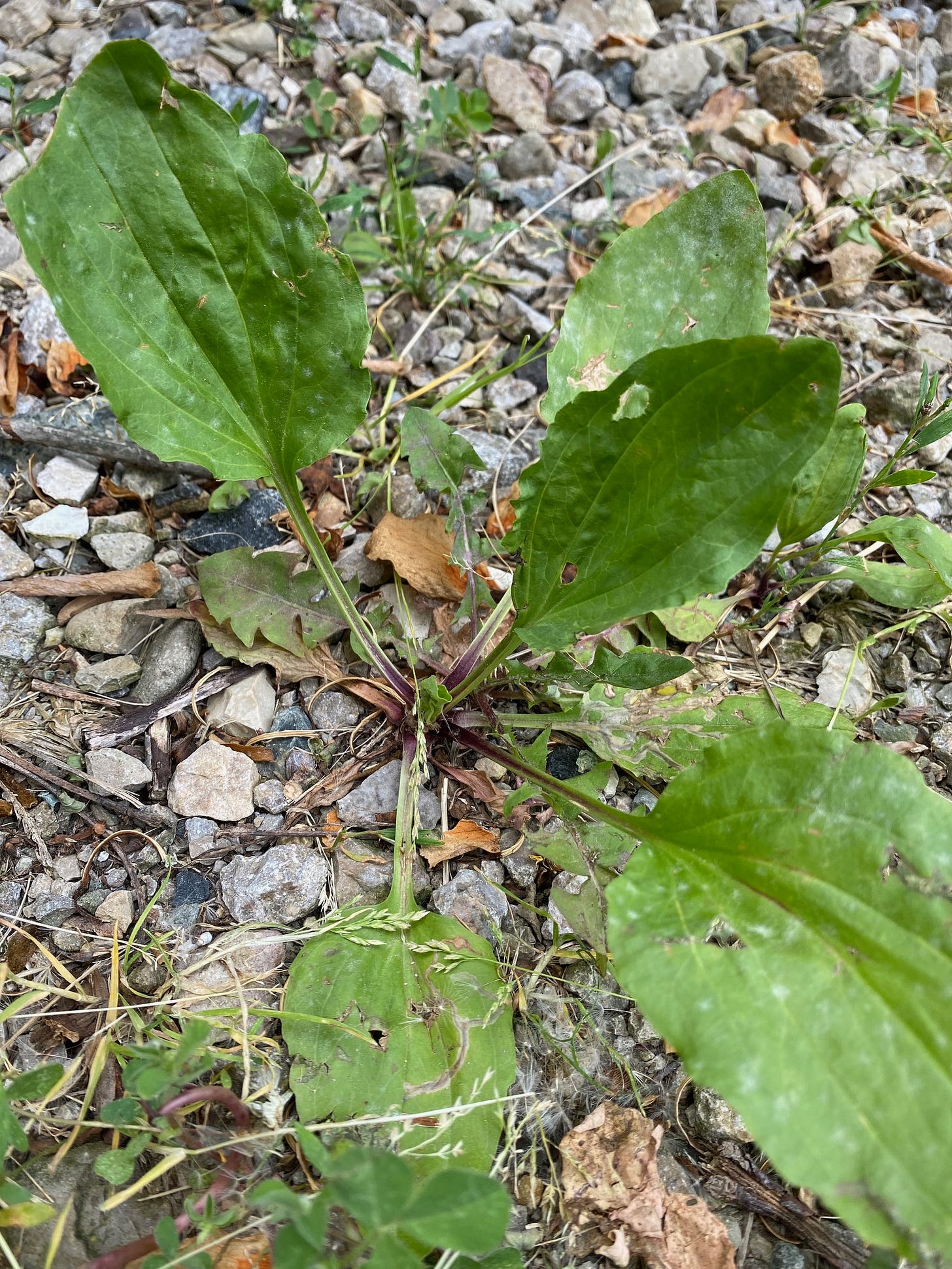

After sticking my arm into a bunch of nettles yesterday, I chewed up a few plantain leaves and wiped the green stuff all over my forearm. Burning gone within a minute never to return.
They were big nettles as well.
I’ve used it for tea and fresh on blisters. Thanks for the info!